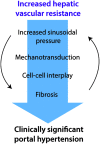Portal Hypertension in Nonalcoholic Fatty Liver Disease: Challenges and Paradigms
- PMID: 37577237
- PMCID: PMC10412712
- DOI: 10.14218/JCTH.2023.00029
Portal Hypertension in Nonalcoholic Fatty Liver Disease: Challenges and Paradigms
Abstract
Portal hypertension in cirrhosis is defined as an increase in the portal pressure gradient (PPG) between the portal and hepatic veins and is traditionally estimated by the hepatic venous pressure gradient (HVPG), which is the difference in pressure between the free-floating and wedged positions of a balloon catheter in the hepatic vein. By convention, HVPG≥10 mmHg indicates clinically significant portal hypertension, which is associated with adverse clinical outcomes. Nonalcoholic fatty liver disease (NAFLD) is a common disorder with a heterogeneous clinical course, which includes the development of portal hypertension. There is increasing evidence that portal hypertension in NAFLD deserves special considerations. First, elevated PPG often precedes fibrosis in NAFLD, suggesting a bidirectional relationship between these pathological processes. Second, HVPG underestimates PPG in NAFLD, suggesting that portal hypertension is more prevalent in this condition than currently believed. Third, cellular mechanoresponses generated early in the pathogenesis of NAFLD provide a mechanistic explanation for the pressure-fibrosis paradigm. Finally, a better understanding of liver mechanobiology in NAFLD may aid in the development of novel pharmaceutical targets for prevention and management of this disease.
Keywords: Hepatic vascular resistance; Hepatic venous pressure gradient; Mechanobiology; Mechanotransduction; Portal venous pressure; Sinusoidal microcirculation.
© 2023 Authors.
Conflict of interest statement
GB has been an associate editor of the Journal of Clinical and Translational Hepatology since 2020. EKM and PP have no conflict of interests related to this publication.
Figures




References
Publication types
LinkOut - more resources
Full Text Sources
